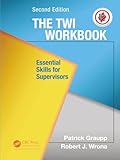The TWI workbook : essential skills of supervisors
By: Graupp, Patrick
Title By: Wrona, Robert J
Material type: BookPublisher: New York : CRC Press Taylor & Francis Group, c2016.Edition: 2nd ed.Description: xxxvii, 317 p. : ill. ; 28 cm.ISBN: 9781498703963Subject(s): Employees -- Training of | Organizational effectivenessDDC classification: 658.3/1243
BookPublisher: New York : CRC Press Taylor & Francis Group, c2016.Edition: 2nd ed.Description: xxxvii, 317 p. : ill. ; 28 cm.ISBN: 9781498703963Subject(s): Employees -- Training of | Organizational effectivenessDDC classification: 658.3/1243 | Item type | Home library | Call number | Status | Date due | Barcode | Item holds |
|---|---|---|---|---|---|---|
| REGULAR | University of Wollongong in Dubai Main Collection | 658.31243 GR TW (Browse shelf) | Available | T0036651 |
, Shelving location: Main Collection Close shelf browser

|

|

|

|

|

|

|
||
| 658.312408 DI VE Diversity in coaching : working with gender, culture, race and age / | 658.3124082 LI BR Breaking through | 658.3124085 SE ME Mentoring new parents at work : a guide for businesses and organisations | 658.31243 GR TW The TWI workbook : essential skills of supervisors | 658.31243 WO RK Workplace learning in context / | 658.31243 WO RK Workplace learning in context / | 658.31243 WO RK Workplace learning in context / |
Includes bibliographical references (p. 189-190) and index.
SECTION I: TWI FUNDAMENTALS Role of TWI at Toyota Early Struggles of Toyota Role of TWI in the Toyota Production System TWI: The Missing Link to Lean Fundamentals of the TWI Program Five Needs Model Common Trait: J Program's Four-Step Methods Common Trait: Learn by Doing Common Trait: Training Session Format Training Manuals: A Standardized Methodology for Delivering Training Identifying Roles and Responsibilities in the TWI Programs SECTION II: JOB INSTRUCTION Four Steps of Job Instruction Workforce Instruction: Two Ineffective Methods Using the JI Four-Step Method Step 1: Prepare the Worker Step 2: Present the Operation Step 3: Try Out Performance Step 4: Follow Up If the Worker Hasn't Learned, the Instructor Hasn't Taught How to Get Ready to Instruct: Break Down the Job Get Ready Point 2: Break Down the Job What Is an Important Step? What Is a Key Point? Identifying the Key Points in the Fire Underwriter's Knot Example Listing the Reasons for the Key Points Making a Balanced Breakdown Observing and Involving Experienced Workers in the Breakdown Process Summary and Sample Breakdowns Breakdown Sheets and Standardized Work Extra Notes on Key Points How to Get Ready to Instruct: Make a Timetable for Training, Get Everything Ready, and Arrange the Worksite Get Ready Point 1: Make a Timetable for Training Get Ready Points 3 and 4: Get Everything Ready and Arrange the Worksite SECTION III: JOB METHODS Applying Job Methods to a Sample Job to Show Before and After Improvements Three Fundamental Classifications of Work Microwave Shield Sample Job: Current Method Microwave Shield Sample Job: Proposed Method Microwave Shield Sample Job: How the New Job Process Works Using the New Method Four Steps of Job Methods Improvement Step 1: Break Down the Job Step 2: Question Every Detail Step 3: Develop the New Method Step 4: Apply the New Method Closing Writing and Selling the Improvement Proposal: Example Proposals: Write It Down and Work Out the Numbers Improvement Proposal Example: Reduction of Workers on the Handset Assembly Line SECTION IV: JOB RELATIONS Job Relations: Working with and through People What Is Good Supervision? Supervisor's Relationship with People People Must Be Treated as Individuals What Is a Problem and How Do You Solve It? Four Steps of Job Relations Get the Objective Step 1: Get the Facts Step 2: Weigh and Decide Step 3: Take Action Step 4: Check Results Did You Accomplish Your Objective? Applying the JR Four-Step Method to the Tina Problem How to Get Opinions and Feelings Problem Prevention Using JR's Foundations for Good Relations How to See Problems Coming The Mike Problem Four Ways the Mike Problem Came Up Foundations for Good Relations The Team Leader Problem Mary's Use of the Foundations for Good Relations Conclusion: The Effect of Change and Problem Prevention SECTION V: JOB SAFETY Four Steps of Job Safety: Preventing Accidents before They Happen Supervisors' Roles and Responsibilities in Safety The Need for Accident Prevention Factors Common to Most Accidents: The Packing Section Example Four Steps of Job Safety Safety Incidents Are Caused; Break the Chain Risky Supervisor Styles Two Key Aspects to Safety: Things and People A Problem with Things: The Miller Example Step 1: Spot the Causes of Danger Step 2: Decide on Countermeasures Step 3: Enforce Countermeasures Step 4: Check Results Rules for Things A Problem with People: The Thomas Example Rules for People Practicing the JS Method The Foreman Morley Example Step 1: Spot the Causes of Danger Step 2: Decide on Countermeasures Steps 3 and 4: Enforce Countermeasures and Check Results Conclusion to Foreman Morley Example Action to Take on Abnormalities What to Do When Injuries Occur Combination of Causes Involving People and Things Workplace Inspection TWI's Problem Solving Training Comparing TWI and Toyota Problem Solving Methods What Is a Problem? Step 1: Isolate the Problem Step 2: Prepare for Solution Step 3: Correct the Problem Step 4: Check and Evaluate Results Conclusion Conclusion-TWI: Key to Changing the Way People Work in Lean Appendix: ESCO Turbine Technologies-Syracuse: Using Job Instruction as a Foundation for Standardized Work Index
Other Titles: Training within industry workbook
Teaching supervisors how to apply a four-step method for each of the three respective programs of Training Within Industry (TWI), the authors encourage hands-on application of the method to actual jobs and employee problems from their own worksites.
